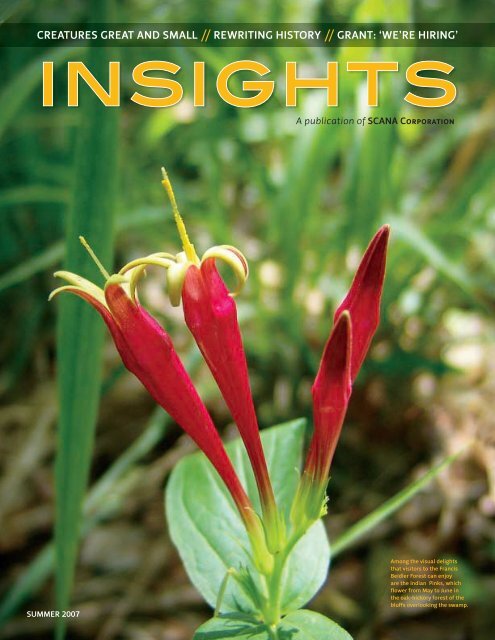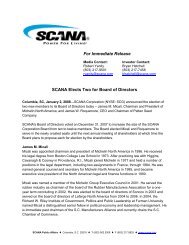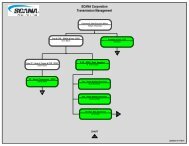Summer 2007 - SCANA Corporation
Summer 2007 - SCANA Corporation
Summer 2007 - SCANA Corporation
Create successful ePaper yourself
Turn your PDF publications into a flip-book with our unique Google optimized e-Paper software.
CREATURES GREAT AND SMALL // REWRITING HISTORY // GRANT: ‘WE’RE HIRING’<br />
A publication of <strong>SCANA</strong> <strong>Corporation</strong><br />
SUMMER <strong>2007</strong><br />
Among the visual delights<br />
that visitors to the Francis<br />
Beidler Forest can enjoy<br />
are the Indian Pinks, which<br />
flower from May to June in<br />
the oak-hickory forest of the<br />
bluffs overlooking the swamp.
FROM THE CHAIRMAN<br />
All about customers<br />
As we go about our work<br />
at <strong>SCANA</strong>, we are focused<br />
on the SACRED values<br />
that are at the heart of<br />
everything we do. These include: Serve our community,<br />
Achieve, Communicate openly and honestly, Respect<br />
diversity and care for each other, Excel in customer<br />
service and safety and Do what is right.<br />
So “excel in customer<br />
service” is not just a goal but<br />
one of our corporate values.<br />
Whether we’re delivering<br />
energy to your home or office<br />
or working with a large<br />
industry, our commitment is<br />
the same.<br />
In this issue of Insights, we<br />
are pleased to focus on two<br />
areas of customer service that<br />
are very different but both<br />
reflect our dedication.<br />
The Edison Electric<br />
Institute, representing<br />
electric utilities from across<br />
the nation, recently honored<br />
two of our employees whose<br />
jobs are dedicated to working<br />
with national accounts — the<br />
big brand businesses that<br />
make their energy decisions<br />
hundreds of miles away.<br />
Primarily via the phones<br />
and the Internet, these<br />
companies rely on our national<br />
account managers to help<br />
meet the energy needs of their<br />
restaurants and stores in our<br />
area.<br />
These big brand companies<br />
cast their ballots at an EEI<br />
workshop, recognizing<br />
SCE&G’s customer service as<br />
the best in the business.<br />
Large industries are<br />
another customer segment<br />
where our service excels,<br />
having earned national<br />
recognition for many years.<br />
Our economic development<br />
team works with local and state<br />
government officials to attract<br />
new and expanding industries<br />
to our region.<br />
Once an industry begins<br />
operations, our large customer<br />
group representatives take<br />
over, helping provide the high<br />
level of service that these<br />
customers need and expect.<br />
Recent recruitment efforts<br />
resulted in a decision by<br />
Ontario-based Grant Forest<br />
Products to build not one but<br />
two plants in South Carolina.<br />
A state-of-the-art,<br />
environmentally friendly<br />
facility is now producing<br />
oriented strand board in<br />
economically depressed<br />
Allendale County.<br />
Reliable, cost-effective<br />
energy was a factor in<br />
their decision. They have<br />
commended the quality and<br />
reliability of their electric<br />
and natural gas service since<br />
opening. Read more about their<br />
story in this issue of Insights.<br />
The theme that you will<br />
find in all of these stories is<br />
a high level of service and<br />
commitment to our customers,<br />
from major manufacturers to<br />
individual homeowners. It’s<br />
a reflection of our values and<br />
focus on serving you.<br />
W.B. Timmerman
InsideSUMMER <strong>2007</strong> • VOLUME 20, NUMBER 2<br />
Editor<br />
Mary Green Brush<br />
Corporate Communications<br />
and Philanthropy Manager<br />
Therese Griffin<br />
Marketing Communications<br />
Director<br />
Cathy Love<br />
Insights is produced quarterly<br />
by the <strong>SCANA</strong> Public Affairs<br />
Dept. <strong>SCANA</strong> Corp is a<br />
$10 billion energy-based holding<br />
company with subsidiaries<br />
providing electric, natural<br />
gas and telecommunications<br />
services.<br />
Call 803-217-8833 if you have<br />
any comments, questions or<br />
ideas for articles, or e-mail<br />
mgbrush@scana.com.<br />
Insights can be viewed on<br />
the <strong>SCANA</strong> home page at<br />
www.scana.com/insights.<br />
Mail Code 063<br />
<strong>SCANA</strong> Corp.<br />
Columbia, SC 29218<br />
© <strong>2007</strong> <strong>SCANA</strong> <strong>Corporation</strong>.<br />
All rights reserved.<br />
Printed on recycled paper<br />
2 Electric rate filing<br />
SCE&G asks the S.C. Public Service Commission for<br />
rate increases to cover the cost of serving customers<br />
4 How do you spell success?<br />
You know them. You use them. You see them<br />
everywhere. Golden Arches. Easy Buttons...<br />
8 ‘We’re hiring’<br />
A new industry in rural South Carolina gives<br />
an economic boost to the region<br />
14 All creatures great and small<br />
From listening to birds to watching fighting lizards,<br />
learning is fun in the Francis Beidler Forest<br />
20 Rewriting history<br />
The Topper archeological site provides evidence of<br />
humans in North America 50,000 years earlier<br />
26 Blue Ribbon School<br />
SCE&G bucket truck captures Seven Oaks Elementary<br />
students spelling out school name for TV flyover<br />
28 NEWS<br />
Storm watch Use new tool to<br />
check power outage status<br />
Safety tips Follow these steps<br />
during stormy weather<br />
Customers in need <strong>SCANA</strong><br />
Energy chosen again as<br />
Georgia’s regulated provider<br />
All product and company names herein may<br />
be trademarks of their registered owners.<br />
SUMMER <strong>2007</strong> • INSIGHTS 1
A message for our<br />
customers<br />
SCE&G filed an application June 15 with the Public<br />
Service Commission of South Carolina requesting an<br />
overall 6.75 percent increase in retail electric base<br />
rates — the company’s first such request since 2004.<br />
If approved, the monthly bill of a residential<br />
customer using 1,000 kilowatt hours of electricity<br />
would increase $7.62 beginning in January 2008.<br />
The company also filed for an overall 1.33 percent<br />
increase to natural gas rates under the terms of the<br />
Natural Gas Rate Stabilization Act.<br />
That request, if approved, would go into effect in<br />
November; residential customers would pay about<br />
$19.70 more a year for natural gas based on average<br />
annual usage.<br />
Public hearings on both requests will be held in<br />
the fall.<br />
SCE&G President and Chief Operating Officer<br />
Kevin Marsh said electric rates are going up because<br />
the company’s cost of serving customers safely and<br />
reliably has gone up.<br />
“The only reason we would ever go in for a rate<br />
increase is because we think it’s essential to our<br />
ability to continue providing our customers with safe,<br />
reliable service,” said Marsh.<br />
BUILDING AND MAINTAINING THE SYSTEM<br />
Marsh said there are a number of key issues<br />
driving the electric rate request, not the least of<br />
which is a substantial increase in costs associated with<br />
building and maintaining SCE&G’s transmission and<br />
distribution system. He said the company has spent<br />
more than $300 million in this area since 2004.<br />
“Our efforts to support the state’s rapidly rising<br />
demand for power have included placing more than<br />
52,000 new poles in the ground; completing nearly<br />
50,000 new service installations; installing more than<br />
20,000 street lights; and adding more than 1,000 miles<br />
of line to our system,” said Marsh.<br />
“Unfortunately, the cost of materials associated<br />
with all that infrastructure — the steel in our<br />
transformers and meters, the copper in our conductors,<br />
the power poles we put in the ground — has risen<br />
tremendously. We’ve seen a 30- to 45-percent increase<br />
in the costs of underground and overhead transformers<br />
and pole hardware since 2004. Wire and cable is up<br />
about 170 percent for that same period.”<br />
Marsh said SCE&G also has made major capital<br />
investments in its generating plants, particularly in the<br />
area of environmental upgrades. “We’ve invested more<br />
than $100 million in clean air technologies at our coalfired<br />
generating plants since our last rate case,” he said.<br />
“While we are certainly committed to conducting<br />
business in an environmentally responsible manner and<br />
to meeting all local, state and federal environmental<br />
requirements, it’s important to understand that there<br />
is a significant cost associated with meeting that<br />
commitment.”<br />
Some have asked whether this rate case includes any<br />
costs associated with SCE&G’s announced plans to build<br />
a new nuclear plant. Marsh said new generation is not<br />
a part of this rate case, and that recovery of any costs<br />
related to construction of a new nuclear plant would be<br />
handled through future rate proceedings.<br />
SCE&G SYSTEM GROWTH & EXPENSES SINCE 2004<br />
$300 million 48,277 30-45 $100 million<br />
Dollars spent on building<br />
and maintenance costs for<br />
SCE&G’s transmission and<br />
distribution system.<br />
New service installations<br />
since last rate case.<br />
Percent increase in costs of<br />
underground and overhead<br />
transformers and pole<br />
hardware.<br />
Invested in clean air<br />
technologies at SCE&G’s coalfired<br />
generating plants.<br />
2 INSIGHTS • SUMMER <strong>2007</strong>
statute is designed to reduce volatility of customer rates<br />
by allowing for more efficient recovery of the costs that<br />
regulated utilities incur in expanding, improving and<br />
maintaining natural gas service infrastructure to meet<br />
the needs of customers. The law also works to reduce<br />
customer rates when a utility’s earnings exceed the<br />
range authorized by the PSC.<br />
“Customer driven growth is the key driver behind<br />
this filing,” said Marsh. “Increasingly, industrial<br />
customers and businesses throughout the state are<br />
demanding availability of natural gas, as are residential<br />
developers and their customers. The requested rate<br />
increase will allow us to continue making the capital<br />
investments that are necessary to expand and safely<br />
operate our natural gas system.”<br />
REGULATORY REVIEW<br />
Marsh emphasized that all the details supporting the<br />
requested increases to electric and natural gas rates will<br />
be examined by the South Carolina Office of Regulatory<br />
Staff and the PSC as part of the regulatory review and<br />
approval process.<br />
“It’s a thorough and transparent process that<br />
balances the needs of our company with the best<br />
interests of our customers and the overall welfare of<br />
South Carolina,” he said.<br />
COMPETING FOR INVESTMENT DOLLARS<br />
According to Marsh, rising inflation and interest<br />
rates also are an underlying factor in this rate case.<br />
Changing financial markets have made it more<br />
challenging for SCE&G to compete for the investment<br />
dollars the company needs to continue building and<br />
maintaining its system.<br />
“In the 12 months leading up to our last rate case<br />
filing, the Federal Reserve had not raised interest rates<br />
even once,” he said. “Since that time, though, rates have<br />
been raised 17 times. Our cost of capital is much higher<br />
today than in 2004.”<br />
To address this, Marsh said SCE&G is asking that<br />
its authorized return on equity be increased from 10.7<br />
percent to 11.75 percent.<br />
NATURAL GAS RATE STABILIZATION ACT<br />
SCE&G filed for an incremental increase to natural<br />
gas rates under a new law that went into effect in 2005<br />
called the Natural Gas Rate Stabilization Act. The<br />
Payment option<br />
Avoid fluctuations in your bill<br />
Some SCE&G customers may be eligible to participate<br />
in the company’s Easy Payment Program. When you<br />
sign up for EPP, your energy usage is estimated based on<br />
historical data from the previous 12 months (if available),<br />
and divided into 12 equal payments. The average is the<br />
amount you pay each month. The amount is “trued-up”<br />
on an annual basis to reflect actual usage and costs. With<br />
EPP, you don’t pay less, but you always know what your<br />
payment will be. It can be a helpful budgeting tool for<br />
customers on a fixed income.<br />
SUMMER <strong>2007</strong> • INSIGHTS 3
How<br />
success?<br />
do you spell<br />
You know them. You<br />
use them. You see them<br />
everywhere. Golden Arches.<br />
Easy Buttons. The Low<br />
Prices smiley face. That red<br />
bulls-eye. You know...<br />
McDonald’s. Staples. Wal-Mart.<br />
Target. To you, they’re probably<br />
a place to get a Big Mac (with<br />
fries and a Coke, please), printer<br />
paper and discount anything and<br />
everything. But to SCE&G’s Kim Lucas and Penny Stevens, each<br />
one is a VIC (Very Important Customer) — which means the same<br />
people who say “How may I help you?” to you are getting the same<br />
question asked of them.<br />
“We’re their single point of contact,” explained Lucas, an SCE&G<br />
national accounts manager in charge of “big box” businesses, such<br />
as discount retailers, grocery and department stores.<br />
“Take Wal-Mart for instance; they have 65-plus stores in our<br />
service territory alone. So, in addition to calling other utilities<br />
across the country, they’re calling us and when they get us, they<br />
don’t want to have to deal with 20 different people to get their<br />
billing, rates information and new service information.”<br />
In other words, Lucas and Stevens are responsible for everything<br />
relating to energy — whether a company is opening a new store,<br />
BY ASHLEY MONTS //<br />
PHOTOS BY JOHN ZICH AND ROBERT CLARK<br />
Photo by John Zich<br />
4 INSIGHTS • SUMMER <strong>2007</strong>
Penny Stevens, an SCE&G<br />
national accounts manager,<br />
meets with Steve DePalo,<br />
national energy manager<br />
for McDonald’s USA at the<br />
company’s 50th anniversary<br />
restaurant in downtown<br />
Chicago.<br />
SUMMER <strong>2007</strong> • INSIGHTS 5
SCE&G Wins J.D. Power Business<br />
Customer<br />
Satisfaction<br />
Award<br />
If one award is exciting, two is<br />
even better. In March, J.D. Power and<br />
Associates named SCE&G the highest<br />
ranking utility in the South for business<br />
customer satisfaction.<br />
The study was based on interviews<br />
with representatives from more than<br />
12,900 U.S. businesses that spend<br />
between $500 and $50,000 per month<br />
on electricity. J.D. Power measured<br />
customer satisfaction through six<br />
factors: power quality and reliability,<br />
customer service, company image,<br />
billing and payment, price, and<br />
communications.<br />
SCE&G improved 43 points from the<br />
year before to beat out Duke Energy,<br />
Progress Energy and Southern Company<br />
in its region. The score was also good<br />
enough to place the company third<br />
in the country for business customer<br />
satisfaction.<br />
shutting one down or trying to find a more cost-efficient<br />
rate plan, that call goes to them.<br />
Now, multiply those needs by 100, which is roughly<br />
the number of large, national accounts Lucas and<br />
Stevens handle proactively, and you get an idea of the<br />
workload. But you don’t get a true snapshot of the job<br />
until you add in the pressure of having customers who<br />
deal with dozens of other utilities on a daily basis.<br />
“They get to compare us to every other utility in the<br />
country,” added Stevens, national accounts manager in<br />
charge of large hotel chains, restaurants, pharmacies<br />
and banks. “They get the big picture.”<br />
And so do these women. Both SCE&G employees for<br />
more than 25 years, they know the company, they know<br />
the business and they know their customers — and while<br />
the first two are impressive, it’s the last one that seals<br />
the deal.<br />
“I seem to know them on more<br />
of a personal level,” said Tom Goetz,<br />
corporate director of engineering<br />
with Dillard’s. “Everyone knows<br />
everyone by their first name and<br />
I can’t say that I know that many<br />
people to that depth in other<br />
utilities.”<br />
“Their attention to customers<br />
is amazing,” added Steve DePalo,<br />
national energy manager for<br />
McDonald’s USA. “I couldn’t do my<br />
job without people like Penny. Not<br />
only is she passionate about helping<br />
customers, she’s accessible and<br />
responsive when we need her.”<br />
Call it southern charm, call it<br />
people skills — whatever you call it,<br />
the bottom line is that it’s friendly<br />
customer service. Actually, it’s<br />
award-winning, friendly customer<br />
service — according to the very<br />
people who matter most, the<br />
customers.<br />
In March, those same big-name<br />
companies cast their ballots at<br />
Edison Electric Institute’s national<br />
accounts workshop in Phoenix,<br />
Ariz. Twenty-five national chain<br />
customers voted on the best<br />
customer service among 101 utilities<br />
— selecting winners in large,<br />
medium and small categories.<br />
“We were having breakfast with<br />
Larry Fichuk, our account contact at Papa John’s, and<br />
when it was time to present the award in the medium<br />
category, he got up and said, ‘See you in a little bit,’”<br />
Stevens recalled. “We didn’t think anything about it<br />
until he got up to the podium and started talking about<br />
two individuals and communications, and then he said<br />
‘South Carolina Electric & Gas’ and we just looked at<br />
each other and thought, ‘No way!’”<br />
“The customers vote on it, so it’s coming from the<br />
right source,” added Lucas. “They tell us that we do a<br />
good job, we know we do a good job, but still… it was a<br />
shocker.”<br />
Perhaps the only SCE&G employee not surprised was<br />
their manager, Steve Chapman. Chapman, who heads up<br />
customer service engineering, learned about the award<br />
SCE&G’s Kim Lucas talks with a Dillard’s employee. Lucas works with<br />
“big box” businesses.<br />
6 INSIGHTS • SUMMER <strong>2007</strong>
the night before and was asked to keep it quiet until the<br />
next day.<br />
“I thought to myself, ‘How am I going to do this?’<br />
I’m surprised they didn’t figure it out because the night<br />
before the awards we were out entertaining customers,<br />
and I kept saying, ‘We need to go ahead and call it a<br />
night. We don’t want to miss the meeting tomorrow<br />
morning,’” laughed Chapman. “I’m just so proud of them<br />
— all of customer service engineering is proud of them.<br />
They work hard and do a really good job.”<br />
Lucas and Stevens knew they worked hard — you<br />
didn’t have to tell them that — but winning the award<br />
showed them something they didn’t know — just<br />
how much that hard work was appreciated. From<br />
picking up the phone to let their customers know<br />
about approaching storms to finding a better rate for<br />
an individual store, the EEI award proved it’s the little<br />
things that sometimes make the biggest impact.<br />
“It was so exciting to see them win because they<br />
constantly make me feel like I’m the most important<br />
customer. This is proof that they’re giving this same<br />
level of customer service to everyone, not just me,” said<br />
Dillard’s Goetz.<br />
“SCE&G winning is because of their dedication to<br />
national accounts,” said DePalo. “They really stand out<br />
because of their proactive communication, which is<br />
what we need.”<br />
Now all Lucas and Stevens have to do is keep it up<br />
— and as easy as that sounds, they both know there’s<br />
no “easy button” when it comes to excellence in<br />
customer service.<br />
“We keep going back thinking, ‘What exactly did we<br />
do last year?’ because we did it without thinking about<br />
it,” laughed Penny. “We’ll just keep doing what we’re<br />
doing because obviously they appreciate it.”<br />
Photos by Robert Clark<br />
McDonald’s honors account manager<br />
Penny Stevens joins elite team as energy efficiency ambassador<br />
One trademark of excellent customer service is going<br />
above and beyond the customer’s expectations. So, when<br />
McDonald’s approached Penny Stevens about joining<br />
their extended energy team, she didn’t think twice about<br />
the extra hours or travel, she just said “yes.”<br />
Stevens is now one of just 15 account executives<br />
from utility companies around the country who act<br />
as an energy efficiency ambassador for McDonald’s.<br />
In that role, she travels to the company’s national and<br />
international conventions educating franchise operators<br />
on energy usage and ways to use energy more wisely.<br />
“She has great interpersonal skills, communications<br />
skills, as well as a wealth of knowledge,” said Steve<br />
DePalo, national energy manager for McDonald’s USA.<br />
“Her professionalism and knowledge about the industry<br />
were key to her being invited to join the team.”<br />
McDonald’s bases selection on three factors: the<br />
utility company must be large enough to serve a<br />
significant number of local restaurants; the account<br />
executive must demonstrate a willingness to help<br />
customers; and the executive must have strong<br />
knowledge of the industry, as well as an understanding<br />
of the McDonald’s culture.<br />
Stevens, it seems, has all three.<br />
SUMMER <strong>2007</strong> • INSIGHTS 7
‘We’re<br />
hiring’<br />
A new industry in<br />
rural South Carolina<br />
gives an economic<br />
boost to the region<br />
Grant Allendale is<br />
hiring in a corner of<br />
Allendale County in<br />
South Carolina.<br />
Grant Forest Products’ announcement<br />
in 2005 of plans to invest $260 million in a<br />
new state-of-the-art manufacturing facility<br />
came as great news to this county, which<br />
at the time had an unemployment rate of<br />
12 percent and an average annual wage of<br />
about $9 per hour.<br />
<strong>SCANA</strong> economic development<br />
representatives and engineers, S.C.<br />
Department of Commerce officials and the<br />
Southern Carolina Regional Development<br />
Alliance worked closely with Grant to<br />
secure and develop an appropriate site,<br />
according to Alliance Executive Director<br />
Danny Black.<br />
BY MARY GREEN BRUSH //<br />
PHOTOS BY ROBERT CLARK<br />
8 INSIGHTS • SUMMER <strong>2007</strong>
Canadian-based Grant Forest Products chose South Carolina as the<br />
location for new state-of-the-art oriented strand board production<br />
facilities. The Allendale site is currently in production, and a sister<br />
plant in Clarendon County will open later this year.<br />
SUMMER <strong>2007</strong> • INSIGHTS 9
High speed blades<br />
shave debarked<br />
logs into six-inch<br />
strands, which<br />
are used to make<br />
oriented strand<br />
board.<br />
He said the Allendale County location fit the<br />
company’s site requirements, including a flat terrain,<br />
location on an accessible highway and availability of<br />
all utilities, including a high pressure natural gas line.<br />
SCE&G played an important role in the recruitment,<br />
providing utility engineering support and financial<br />
assistance for infrastructure needs.<br />
Site Manager Van Chatraw, who joined the company<br />
from Weyerhaeuser Corp. after the plant was built,<br />
said, “The company wanted to put the plant where the<br />
resources are, which include resin, trees and people.”<br />
Grant Forest Products, based in Ontario, Canada,<br />
chose Allendale and Clarendon counties in South<br />
Carolina for its new oriented strand board (OSB)<br />
facilities. The abundance of “plantation” pine — trees<br />
10 to 20 years old — was a major factor, Chatraw said.<br />
Most of the pine trees are grown within 70 miles of the<br />
plant. They are considered a renewable energy source<br />
because they grow in a relatively short period of time<br />
as compared to a hardwood tree that might take 75-100<br />
years to reach the age of harvest.<br />
In addition to buying pines grown specifically to<br />
be cut and used while young, the company also buys<br />
similarly sized pine trees that have been cleared as part<br />
of thinning during forest management projects. These<br />
trees previously had little market value.<br />
Grant Allendale is a state-of-the-art facility, the<br />
largest of its kind in the world. Last year the plant<br />
produced more than 850 million square feet of OSB. “We<br />
have the fastest line speeds in the world,” Chatraw said.<br />
But while many of the plant processes are automated,<br />
people are still needed to run it.<br />
“We also moved here because the people are<br />
a resource that is untapped. There is not a lot of<br />
manufacturing here, and people are transitioning from<br />
agriculture as a major employer,” he said.<br />
The plant continues to hire in positions from<br />
management and engineering jobs to maintenance and<br />
production employees. Most training takes place on the<br />
job. “We’re looking for high energy, innovative thinkers<br />
who can handle change. We incent for performing in<br />
innovative ways.”<br />
ORIENTED STRAND BOARD SUPPLIES BUILDING TRADE<br />
Grant Allendale uses pines and people to produce<br />
OSB, an engineered wood panel made from resins and<br />
multiple layers of wood strands. Each six-inch strand is<br />
oriented perpendicularly to the layer above and below it,<br />
resulting in a product similar to the strength and quality<br />
of plywood. OSB is used in the construction industry as<br />
an economical alternative.<br />
10 INSIGHTS • SUMMER <strong>2007</strong>
Van Chatraw, site<br />
manager at Grant<br />
Allendale, explains<br />
a process to Sid<br />
Ballentine, SCE&G<br />
account manager.<br />
Chances are if you have a newer home that this<br />
product may be used in your roofing, siding and<br />
subflooring.<br />
In fact, Grant Allendale produces OSB in lengths<br />
from eight feet to 10 to accommodate the higher<br />
ceilings that are standard in many homes today.<br />
Committed to environmental sustainability, Grant<br />
Allendale uses all of the trees it purchases from area<br />
growers. Even the scraps on the floor are used to fire<br />
the high-temperature wood-burning furnaces that heat<br />
the dryers used in the production process.<br />
RELIABLE ENERGY A REQUIREMENT<br />
While the furnaces are fueled by wood, with natural<br />
gas as a backup source, the plant’s sensitive electronics<br />
and automated processes rely on a reliable supply<br />
of electricity. Chatraw has found SCE&G to be very<br />
responsive when a problem occurs. In one instance,<br />
SCE&G personnel were on site within 15 minutes. The<br />
plant also has backup generators available in case they<br />
are needed.<br />
Natural gas is used to burn off contaminants in the<br />
plant’s air cleaning system, assuring that the company’s<br />
high environmental standards are met with only steam<br />
released to the environment.<br />
Chatraw has been pleased with the energy supply<br />
and service at the new plant. “We’re a 24-hour-a-day<br />
operation. Power is essential. People don’t run a plant<br />
24 hours a day unless there is an opportunity for profit,<br />
so the more we can keep it running the better. Keeping<br />
the plant running is essential to our success.”<br />
SERVING A WAITING MARKET<br />
Buyers are waiting for Grant Allendale’s OSB as<br />
soon as it is produced. In fact, most of the merchandise<br />
in the plant warehouse at any single time is already<br />
pre-sold.<br />
The boards come off the manufacturing line, are cut<br />
into lengths, bound, stamped with the company logo<br />
and loaded onto trucks, headed to housing markets<br />
along the S.C. coast, apartment complexes being<br />
developed, and a host of other buyers.<br />
“We’re located near our market, which is the<br />
Southeast, one of the fastest growing regions in the<br />
country. Our sales force sells to wholesalers and<br />
brokers as well as major suppliers buying in large<br />
volumes,” Chatraw said.<br />
To help accommodate this market, Grant Allendale<br />
has a sister plant under construction in Clarendon<br />
County, also an economically depressed area of the state.<br />
Grant Allendale came on line first, producing its first<br />
board Oct. 30, 2006. Now those employees are helping<br />
the Clarendon plant get off the ground. Employees from<br />
the two plants are working closely together to bring<br />
Clarendon County on line in the fourth quarter of <strong>2007</strong>.<br />
Grant Forest Products pursued a strategy of building<br />
two identical plants near each other so that they can<br />
share resources and skilled labor. Any associate will be<br />
prepared to work at either plant.<br />
SUMMER <strong>2007</strong> • INSIGHTS 11
It starts<br />
with a<br />
tree...<br />
Major steps in creating oriented<br />
strand board include:<br />
1<br />
The process starts with a log,<br />
which is debarked and then<br />
shaved into six-inch strands using<br />
high-speed blades.<br />
2<br />
The strands are sent to a<br />
high-temperature dryer<br />
to remove moisture. (Trees are 55<br />
percent water. The goal is to get the<br />
strands to 4-5 percent water.)<br />
3<br />
In the blending process, the<br />
strands are mixed with glue<br />
and wax (resin), then transported<br />
to a forming line where a process<br />
begins that is much like making a<br />
six-layer cake.<br />
4<br />
Strands are cut into a mat<br />
size of 12 feet by 26 feet<br />
and loaded into an oven on shelves.<br />
They go into a press where heat<br />
and pressure cure the resin and<br />
wax and condense each mat from<br />
eight inches thick to one-half inch<br />
thickness.<br />
5<br />
The mats move down the saw lines, where they<br />
are cut into boards that are four by eight feet,<br />
nine feet or 10 feet.<br />
A BOON FOR THE ENTIRE REGION<br />
Grant Allendale is a boon for local mom-and-pop<br />
businesses, and new companies are springing up to<br />
provide such services as saw blade sharpening, machine<br />
work and trucking, Alliance Director Black said.<br />
Most of the plant’s employees live within the fourcounty<br />
area around the facility. “My wife and I enjoy the<br />
area,” said Chatraw, who moved from Kentucky. “The<br />
people are friendly and the community really opened<br />
up to the Grant people who moved here.” The plant<br />
currently employs 130 people.<br />
12 INSIGHTS • SUMMER <strong>2007</strong>
The plant has room for expansion in the future as<br />
the 26-year-old Grant Forest Products continues to<br />
grow as one of the world’s leading producers of OSB and<br />
engineered wood products.<br />
The success story began in Northern Ontario, spread<br />
through Canada and now — with the addition of two<br />
plants in South Carolina — North America.<br />
Most of the oriented strand board produced at Grant Allendale is<br />
already pre-sold and is shipped directly to waiting markets, primarily<br />
in the fast-growing Southeast.<br />
Visit www.scana.com/insights to view a video about Grant.<br />
SUMMER <strong>2007</strong> • INSIGHTS 13
Photo by Mark Musselman<br />
The Yellow-crowned Night Heron dines exclusively on crayfish while<br />
nesting in the Francis Beidler Forest.<br />
All creatures<br />
great<br />
and small<br />
From listening to birds to<br />
watching fighting lizards,<br />
learning is fun in the<br />
Francis Beidler Forest<br />
BY MARY MARLOWE LEVERETTE //<br />
PHOTOS BY ROBERT CLARK<br />
14 INSIGHTS • SUMMER <strong>2007</strong>
Let children walk with Nature, let<br />
them see the beautiful blendings and<br />
communions of death and life… as taught<br />
in woods and meadows, plains and<br />
mountains, and streams of our blessed<br />
star… John Muir, naturalist<br />
The sunlight-dappled boardwalk offers a<br />
view of two of our planet’s most precious<br />
resources, the majesty of Francis Beidler<br />
Forest and the wonderment of our<br />
children. It is the fascination reflected<br />
on each child’s face that reminds even<br />
the most jaded observer that this serene<br />
sanctuary is a special place.<br />
The occasion is a visit to the SCE&G<br />
Outdoor Classroom at Francis Beidler<br />
Forest in South Carolina’s Lowcountry.<br />
Designed to support the idea of teaching<br />
children about nature in a natural setting,<br />
the classroom provides ample space for<br />
experiments and hands-on learning.<br />
“We named it the SCE&G Outdoor<br />
Classroom as an acknowledgement of<br />
their many years of generous support,<br />
including a major gift to our capital<br />
campaign allowing us to purchase some<br />
critical habitat to expand the preserve,”<br />
SUMMER <strong>2007</strong> • INSIGHTS 15
Vance-Providence<br />
Elementary School<br />
students experience<br />
the mystery and<br />
beauty of the Francis<br />
Beidler Forest.<br />
explains Norman Brunswig,<br />
executive director of Audubon<br />
South Carolina.<br />
Nestled among towering<br />
trees, the screened, open-air<br />
classroom is perched on the<br />
edge of the swamp, creating<br />
the perfect opportunity for<br />
spontaneous observation<br />
sessions.<br />
Sixty children from Vance-<br />
Providence Elementary in<br />
Orangeburg County are here to<br />
participate. Vance-Providence<br />
has a long-standing relationship<br />
with SCE&G as one of the more<br />
than 30 SCE&G Homework<br />
Centers in schools in North<br />
Carolina, South Carolina<br />
and Georgia.<br />
Managed by the National<br />
Audubon Society, Francis<br />
Beidler Forest, a registered<br />
National Natural Landmark, is<br />
a part of Four Holes Swamp.<br />
The forest covers the central<br />
and southeast portions of the<br />
swamp-stream system as it<br />
meanders through Orangeburg<br />
and Dorchester counties on its<br />
way to the Atlantic Ocean.<br />
In the 1890s Francis<br />
Beidler, a lumber baron,<br />
purchased a tract of land in the<br />
swamp with the intention of<br />
logging its cypress. But after<br />
journeying west and visiting<br />
Yellowstone National Park, Beidler became a champion<br />
of conservation and steadfastly refused to log in the area.<br />
Following his death in 1924, family members<br />
maintained the integrity of the land, and in the 1960s<br />
The Nature Conservancy and the National Audubon<br />
Society combined their resources to purchase what is<br />
now Francis Beidler Forest. An additional 909 acres<br />
were acquired in October 2003.<br />
Visitors wander past ancient trees, blackwater<br />
swamp, clear pools and wildlife along a 1.75-mile<br />
elevated boardwalk that starts and ends at the visitors’<br />
center. Along the self-guiding trek are plenty of<br />
benches to pause for observation and reflection of this<br />
pristine sanctuary.<br />
In the still, humid heart of the forest, ancient<br />
groves of bald cypress trees stretch skyward their<br />
shaggy, reddish trunks, towering over clear pools and<br />
blackwater sloughs. Within its 15,000 acres stands the<br />
largest virgin bald cypress and tupelo gum swamp forest<br />
left anywhere in the world. Some of the sanctuary’s<br />
cypresses have been dated at 1,100 years old and exceed<br />
nine feet in diameter.<br />
Species of oak, ash, tupelo and black gum make up<br />
an understory that grows as high as 70 feet, filling the<br />
vaulted spaces between the towering cypresses. The<br />
characteristic “blackwater” is actually clear but appears<br />
black due to the tannic acid in the bark and leaf litter on<br />
16 INSIGHTS • SUMMER <strong>2007</strong>
Students from<br />
Vance-Providence<br />
Elementary School<br />
enjoy learning about<br />
the natural world<br />
both in the outdoor<br />
classroom at the<br />
Beidler Forest and<br />
on the boardwalk.<br />
IF YOU’RE<br />
GOING...<br />
Francis Beidler Forest is located in<br />
South Carolina’s Dorchester County<br />
about five miles off Interstate 26 near<br />
Harleyville. Beidler Forest is open<br />
Tuesday through Sunday from 9 a.m.<br />
until 5 p.m. and is closed on select<br />
holidays. Admission is $7 per adult;<br />
$6 for adult Audubon members; $3.50<br />
per child 6–18 and children below 6<br />
free. The Visitors’ Center offers helpful<br />
naturalists, interactive displays, bird<br />
identification computer stations and<br />
amenities to enhance your visit. Canoe<br />
trips and naturalist-guided walks and<br />
programs are available seasonally<br />
and by reservation. Call 843-462-2150<br />
for directions or visit the Web site at<br />
www.beidlerforest.com.<br />
the swamp floor. In many areas, the water serves as a<br />
near perfect mirror to the giant cypress knees rising like<br />
wizened spirits.<br />
Reptiles and amphibians — turtles, alligators, snakes,<br />
lizards, frogs and toads — thrive in large populations.<br />
While some may consider them merely pests, the<br />
swamp is filled with delicate and fascinating creatures<br />
that deserve a moment in the spotlight: spiders, beetles,<br />
butterflies and grasshoppers, as well as the thousands<br />
of microinvertebrates in streams and ponds teeming<br />
with fish. Within the diverse topography of the forest,<br />
mammals abound, including white-tailed deer, gray and<br />
red foxes, otters, bats, beavers, mice, feral hogs and an<br />
occasional bobcat.<br />
As expected, birding in the forest is spectacular.<br />
Every season offers a show as waterfowl, birds of prey,<br />
wading birds, warblers and woodpeckers inhabit the<br />
swamp. A familiar sight is the golden sprite of the<br />
swampy woods, the Prothonotary Warbler. Its clear,<br />
emphatic song breaks the stillness as it flashes high<br />
among the trees. And, as twilight settles, the swamp<br />
echoes with the rich baritone hoots of Barred Owls.<br />
SUMMER <strong>2007</strong> • INSIGHTS 17
The SCE&G<br />
Outdoor Classroom<br />
provides space for<br />
experiments and<br />
hands-on learning<br />
about nature in a<br />
natural setting.<br />
18 INSIGHTS • SUMMER <strong>2007</strong>
LESSONS EXPERIENCED<br />
The clearest way into the universe is through a forest<br />
wilderness. John Muir<br />
Once inside the SCE&G Outdoor Classroom,<br />
Education Director Mark Musselman gives each<br />
student a photo of a plant, insect or other animal. The<br />
photos are used to create food chains and ultimately<br />
a complex food web explaining the intricacies of the<br />
forest eco system. Every child is given the opportunity<br />
to participate, and excitement grows as it becomes clear<br />
that all things in nature are linked and must coexist to<br />
insure survival.<br />
Musselman’s question, “Who likes snakes?” elicits a<br />
noisy response. Although the majority of the students<br />
indicate that they do not like snakes and offer some<br />
creative methods of ridding the world of snakes, they<br />
soon discover that the food web quickly falls out of<br />
balance if all the snakes or any group of animals are<br />
removed. While the lesson is designed to be a fun<br />
learning experience, it is what happens next that<br />
unleashes a child’s wonderment and curiosity about<br />
nature.<br />
The eager learners move outside to observe the<br />
mysteries of the swamp and to look for relationships<br />
between plants and animals. Using the information<br />
they just learned, the children easily identify and find<br />
examples of an animal’s basic needs — food, water,<br />
shelter and space.<br />
As Musselman points out insect holes in a decaying<br />
cedar log and the precision-drilled woodpecker holes in<br />
a nearby tree, the wide-eyed students see the evidence<br />
of the web of life that must exist in a healthy forest.<br />
With their eyes moving upward, the students see<br />
the Southern birds of prey cousins — black and turkey<br />
vultures soaring high above the trees. Spotting the<br />
vultures offers an opportunity to discuss the birds’ use<br />
of air currents and the importance of carrion eaters<br />
within the food chain.<br />
Just a few more steps and squeals incite a wave of<br />
pointing fingers as a red-bellied water snake makes its<br />
way through the dry forest bed, heading back toward<br />
the water. While some seem to recoil in fear, others are<br />
itching to give the snake a helping hand. The whoops<br />
and laughter may have been a bit too much for a mother<br />
deer and her fawn that leave only their tracks behind<br />
while heading for thicker cover.<br />
The children’s nearly all-consuming fascination with<br />
Spiderman supports an appreciation of the forest’s wolf<br />
spiders and their intricate webs designed for strength<br />
and capture. “Use your superior<br />
observation skills and height<br />
advantage to study the forest floor,”<br />
Musselman encourages.<br />
He directs the children to look<br />
for evidence of creatures unseen,<br />
like the caterpillar-chewed leaves,<br />
The lungs of the earth<br />
Virgin forestland offers research opportunities<br />
Four Holes Swamp holds the<br />
mysteries of thousands of years deep<br />
in its waters, flora and fauna. It is those<br />
mysteries that have kept Norman<br />
Brunswig’s passions fired, as his dream<br />
of creating a regional preserve at<br />
Beidler has become a reality.<br />
Hired in 1973 as Francis Beidler<br />
Forest’s first manager, Brunswig’s<br />
persistence and his ability to articulate<br />
his vision has created a sanctuary that<br />
offers educational opportunities for the<br />
community, influences local decision<br />
makers, preserves and enhances<br />
habitat, and functions as the core of<br />
watershed conservation efforts.<br />
“Forests are the lungs of the earth,<br />
and it is our responsibility to keep<br />
them healthy,” says Brunswig, now<br />
executive director of Audubon South<br />
Carolina. “Here in one of the remaining<br />
virgin, old growth forests, students<br />
of wildlife management, forestry and<br />
plant ecology can conduct studies that<br />
benefit woodlands and their inhabitants<br />
worldwide.”<br />
One important study follows the<br />
impact of habitat destruction on<br />
spotted turtle populations. Relying on<br />
Canadian research begun in 1977 in<br />
the northern region of their range, Dr.<br />
Jackie Litzgus spent three years in Four<br />
Holes Swamp tracking these swamp<br />
denizens using radio transmitters.<br />
all the while linking each discovery<br />
into the food chain of life. With<br />
all their senses heightened, these<br />
children have begun a journey of<br />
exploring nature. It will be through<br />
their embrace that treasures like the<br />
Francis Beidler Forest will endure.<br />
A recipient of a National Geographic<br />
Research Grant, Dr. Litzgus continues<br />
to monitor the well-being of the Beidler<br />
Forest spotted turtles from her home<br />
in Canada, where the species has been<br />
placed on the endangered list.<br />
Scientists from Audubon, Clemson<br />
University, Cornell University,<br />
Mississippi State University and the<br />
University of South Carolina have also<br />
studied the Southeastern Big-eared<br />
Bat, insects, fish, breeding birds and<br />
their migration, other reptiles and<br />
amphibians, botanical adaptations,<br />
the impacts of hurricane destruction,<br />
hydrology and seepage fins.<br />
As part of a 29-year study by Dr.<br />
John Morse, Clemson University’s<br />
Department of Entomology, quarterly<br />
benthic organism samples and water<br />
samples are collected in the preserve.<br />
Depending on the number and species<br />
of organisms present, the staff can<br />
determine if the water quality is poor to<br />
excellent. The collected organisms are<br />
sent to Morse along with water sample<br />
data. Brunswig is pleased to report that<br />
the water in the Francis Beidler Forest<br />
portion of Four Holes Swamp continues<br />
to be of high quality.<br />
Visit www.scana.com/insights to view a<br />
video about Beidler.<br />
SUMMER <strong>2007</strong> • INSIGHTS 19
Rewriting history<br />
at Topper<br />
Allendale dig dates<br />
humans in North<br />
America 50,000<br />
years earlier than<br />
common beliefs<br />
When we<br />
look to<br />
history,<br />
we often<br />
find what we expect to find<br />
— a neat timeline of cultural<br />
advances.<br />
We convince ourselves<br />
through conventional<br />
wisdom that we know all<br />
there is to know about<br />
science, technology… even<br />
history. But sometimes<br />
someone discovers artifacts<br />
that have lain dormant for<br />
tens of thousands of years,<br />
and conventional wisdom is turned upon its head.<br />
In Allendale County, professional and amateur<br />
archaeologists and historians led by Dr. Al Goodyear, a USC<br />
archaeology professor, are excavating what is commonly<br />
referred to as the Topper site. More properly, it’s called the<br />
Allendale Paleoamerican Expedition.<br />
BY SAM MORTON //<br />
PHOTOS BY ROBERT CLARK<br />
20 INSIGHTS • SUMMER <strong>2007</strong>
Dr. Al Goodyear,<br />
professor of<br />
archaeology at the<br />
University of South<br />
Carolina, stands in<br />
the “pit” at<br />
the Topper<br />
excavation, a fourmeter-deep<br />
site that<br />
represents nearly<br />
50,000 years of<br />
human history.<br />
SUMMER <strong>2007</strong> • INSIGHTS 21
Archaeological<br />
work at the Topper<br />
site is slow and<br />
painstaking,<br />
although the tools of<br />
the trade are simple.<br />
For most of the 20th<br />
century, archaeologists<br />
believed that the first<br />
people to inhabit North<br />
America were huntergatherers<br />
who migrated<br />
over the frozen Bering<br />
Strait bridge that<br />
connected Siberia and<br />
Alaska. These hunters<br />
followed the big game<br />
south and east.<br />
They were known as<br />
Clovis people following the<br />
discovery in the 1930s of<br />
complex spear points and<br />
tools in an excavation near<br />
Clovis, N.M. “For years<br />
they have been the most<br />
widely recognized human<br />
culture for this continent,”<br />
Goodyear said.<br />
In 1998, Goodyear<br />
led a group of amateur<br />
archaeologists to a patch<br />
of Allendale County<br />
land owned by Clariant<br />
<strong>Corporation</strong>, a Swissowned<br />
chemical company.<br />
He and the team had<br />
intended to excavate what<br />
he anticipated would be an<br />
artifact-laden Clovis site.<br />
Unfortunately, it had<br />
been raining pretty heavily<br />
and the soil the team<br />
intended to unearth had<br />
the consistency of peanut butter. It was impossible to<br />
dig there. Still, Goodyear had a group of people who had<br />
paid for the experience of excavating, so he picked an<br />
alternate site on higher ground near the Savannah River,<br />
known as Topper.<br />
When he and his team had exhausted their finds at<br />
the depth referred to as the Clovis level, they decided<br />
to dig deeper. A few feet below Clovis — representing<br />
thousands of years in time — the team began discovering<br />
distinctly different artifacts.<br />
Goodyear’s work at the Topper site has yielded<br />
archaeological evidence that suggests that humans<br />
may have been in the area as much as 50,000 years<br />
earlier than previously thought. “It was not just that<br />
the artifacts were older. They were much different than<br />
what we would expect to find if we were just looking at<br />
an older version of the same kind of tool.”<br />
Clovis tools yielded blade-like slivers of flint, known<br />
as prismatic blades. They were also long and often large.<br />
The pre-Clovis scrapers and blades are shorter, lack<br />
that distinctive appearance and tend toward beak-like<br />
hooked points rather than arrowhead-shaped ends.<br />
On the last day of the dig, the team found a charcoal<br />
deposit that allowed for radiocarbon dating. The<br />
Boulder, Colo. lab that tested samples from the deposit<br />
dated it at 50,000 years old.<br />
Working in open trenches under the hot summer<br />
sun may not have dampened anyone’s enthusiasm or<br />
22 INSIGHTS • SUMMER <strong>2007</strong>
Volunteers pay<br />
to spend a week<br />
excavating at the<br />
Topper site each<br />
summer, either<br />
camping or staying<br />
in nearby motels.<br />
hindered any important discovery, but it made for<br />
grueling labor. With a contribution <strong>SCANA</strong> made<br />
through the Southern Carolina Regional Development<br />
Alliance, Goodyear and his team were able to erect a<br />
shelter over the dig, providing much needed relief for<br />
the archaeologists and important protection for the<br />
dig itself.<br />
“It’s an impressive shelter,” Goodyear said. “Along<br />
with a viewing deck that Clariant employees built on<br />
their lunch hours, it provides a way for people to see<br />
the work as it happens without injuring themselves or<br />
damaging the dirt around the dig. Most important is<br />
that it stands over what may<br />
be the most significant earlyman<br />
dig in America.”<br />
The shelter is sturdy and<br />
stands 50 feet by 70 feet. “It<br />
more than covers the footprint<br />
of our dig,” said Bob Cole,<br />
an avocational archaeologist<br />
who has been with Goodyear<br />
since the discovery of the<br />
Topper site. “We dug about 30<br />
centimeters below the Clovis<br />
level and came upon a feature<br />
that looked distinctly non-<br />
Clovis,” he said.<br />
Cole said the heat on those<br />
first digs was merciless. “The<br />
sun was brutal. It felt like<br />
it was 120 degrees, and we<br />
didn’t have any cover.” The<br />
team was easily dehydrated,<br />
drenched in perspiration, and<br />
the no-see-ums were so thick<br />
and aggressive that you could<br />
actually see them.<br />
The shelter also performs<br />
a function just as important<br />
as protecting the excavators<br />
— it protects the site itself.<br />
The pre-Clovis artifacts are<br />
about four meters below the<br />
surface. “When it would rain,”<br />
Goodyear said, “the runoff<br />
would wash leaves and plastic<br />
and other trash into the site.”<br />
Danny Black, executive<br />
director of the Southern Carolina Regional Development<br />
Alliance, said the Topper discovery provides the region<br />
with the prospect of tourism in the future. “From our<br />
standpoint, having this site with its potential impact<br />
on history has huge possibilities, from public tours to<br />
museum exhibits of the artifacts.”<br />
Goodyear said it is clear that people who came to<br />
this site, Clovis and those before, came there to quarry<br />
the rock. “They used it to make microlithic tools, that is<br />
tools to make other tools out of bone or wood or antlers.<br />
These people may have stayed for days or weeks at a<br />
time,” he said.<br />
These men and women from prehistory are<br />
somewhat like Goodyear’s band of volunteers who<br />
SUMMER <strong>2007</strong> • INSIGHTS 23
Volunteer<br />
archaeologists with<br />
the Allendale<br />
Paleoindian<br />
Expedition uncover<br />
evidence of early<br />
human civilization<br />
beneath a shelter<br />
that a <strong>SCANA</strong><br />
contribution helped<br />
provide.<br />
come for a few weeks to dig into the dirt to quarry<br />
history. They range in age from retirees like Cole and<br />
Ted Brown from Pascagoula to Paula Zitzelberger, a<br />
high school classmate of Goodyear’s who read about his<br />
discovery and spent her vacation at Topper , as well as<br />
three University of Tennessee students — Betsy McLean,<br />
Marina Margolin and Adam Russell.<br />
Unwittingly, this group may have been in on the most<br />
significant event at the site since the discovery of the<br />
pre-Clovis artifacts in 1998. “It’s widely accepted that<br />
about 13,000 years ago, mastodons, mammoths and the<br />
Clovis people disappeared just like that,” Goodyear said<br />
snapping his fingers.<br />
One theory is that a large comet struck North<br />
America and began another ice age, one that would<br />
have killed mammoths, mastodons and Clovis man<br />
alike. “Scientists came to our site and at the Clovis level,<br />
checked the sediment for iridium, the tell-tale sign of a<br />
comet strike. At that level at our site, they found iridium<br />
in abundance,” Goodyear said.<br />
He and 22 other scientists presented their findings<br />
at a scientific symposium in Mexico earlier this year.<br />
The journal Nature did a breaking news story on this<br />
conference, which has given further momentum to the<br />
comet theory.<br />
With purpose and determination, Goodyear and his<br />
volunteers are both discovering history and changing<br />
our notions of it. Centimeter by centimeter they scrape<br />
and brush away sand to uncover who we are and where<br />
as a culture we came from. And with partners like<br />
<strong>SCANA</strong> and others, their search for answers is done<br />
more efficiently, and more comfortably, than ever before.<br />
Archaeological projects at SCE&G<br />
SCE&G has a long-standing history of involvement in<br />
discovering and protecting archaeological sites around<br />
the state.<br />
One of the most significant projects to date is the<br />
Congaree Creek Heritage Preserve, a 627-acre tract<br />
of land purchased for the people of South Carolina in<br />
1998 through the Governor’s Legacy Trust Fund, the<br />
Department of Natural Resources’ Heritage Land Trust<br />
Fund and donation of property by SCE&G valued at<br />
$500,000.<br />
Located in Cayce, S.C., the 627-acre preserve is<br />
tucked away in a pristine setting where visitors can<br />
enjoy bountiful wildlife, forest parks and 12,000 years of<br />
history and pre-history.<br />
Archaeological studies have indicated that Native<br />
Americans moved through the area as much as 12,000<br />
years ago, drawn to the clean, clear waters of the<br />
Congaree River.<br />
The first Anglo-Saxon settlement in the area was<br />
established at Fort Congaree in 1718, followed by the<br />
community of Saxe Gotha Township in 1731. Gradually<br />
settlers migrated across the river to higher ground that<br />
became the City of Columbia. By the mid-1700s Saxe<br />
Gothe all but vanished until rediscovered during an<br />
archaeological study funded by SCE&G.<br />
Today, the area is managed by the Department of<br />
Natural Resources and is open to the public during<br />
daylight hours year-round. Visit www.dnr.sc.gov/<br />
managed/heritage/congcreek/description for more<br />
information and directions.<br />
SCE&G continues to conduct archaeological surveys<br />
as part of its hydroelectric relicensing projects. A<br />
survey is currently underway on Lake Murray and the<br />
lower Saluda River as part of the Saluda Hydroelectric<br />
relicensing project.<br />
Surveys completed in conjunction with the<br />
relicensing of the Stevens Creek and Neal Shoals<br />
Hydroelectric Projects can be found on the company’s<br />
Web site at www.sceg.com/arch.<br />
Visit www.scana.com/insights to view a video about Topper.<br />
24 INSIGHTS • SUMMER <strong>2007</strong>
SUMMER <strong>2007</strong> • INSIGHTS 25
Seven Oaks Elementary earns<br />
An SCE&G bucket truck was used<br />
to photograph the Seven Oaks<br />
students spelling out the school<br />
name for a television flyover. The<br />
school is located in Lexington-<br />
Richland School District 5 near<br />
Columbia, S.C.<br />
Photos by Eric Alkire<br />
26 INSIGHTS • SUMMER <strong>2007</strong>
Blue Ribbon School award<br />
SUMMER <strong>2007</strong> • INSIGHTS 27
News<br />
UPDATES FROM OUR COMPANIES & CUSTOMERS<br />
Safety tips<br />
Follow these steps<br />
during stormy weather<br />
Stay alert to storm advisories<br />
and evacuate if told to do so.<br />
Have flashlights and fresh<br />
batteries on hand.<br />
Turn off and unplug electronics<br />
and appliances when a storm is<br />
imminent.<br />
Do not attempt to connect a<br />
generator to your home’s main<br />
circuit; instead, plug appliances<br />
directly into the generator. Failure<br />
to follow these instructions can be<br />
harmful, even deadly.<br />
Do not ever touch a downed<br />
power line. Contact SCE&G<br />
immediately at 1-888-333-4465 to<br />
report it.<br />
Never try to remove a tree<br />
limb or any other object that is<br />
in contact with a power line. Call<br />
SCE&G for help.<br />
For more information on<br />
storm safety or SCE&G’s power<br />
restoration process, visit<br />
www.sceg.com/storm.<br />
Storm watch<br />
Check the status of a power outage from<br />
work, a laptop or PDA with this new tool<br />
The hurricane season is upon us, and SCE&G<br />
wants to let customers know they have more<br />
options this year when it comes to reporting<br />
or checking the status of a power outage.<br />
In addition to calling customer service at<br />
1-888-333-4465, customers can also report an<br />
outage and check the status of an outage online by going to<br />
www.sceg.com/storm. While online, customers can also view<br />
SCE&G’s outage map, which shows the number of outages<br />
in service areas across the state. However, if Internet<br />
access is simply not an option, this same information is also<br />
available through the company’s automated voice response<br />
system. In the event of a storm, the company will utilize its<br />
high-volume call-answering system to effectively manage<br />
the increased number of calls.<br />
Serving customers<br />
in need in Georgia<br />
Georgia PSC chooses<br />
<strong>SCANA</strong> Energy again<br />
The Georgia Public Service<br />
Commission announced June 19<br />
that <strong>SCANA</strong> Energy will continue<br />
to serve as Georgia’s sole<br />
regulated provider of natural gas,<br />
a role the company has had since<br />
the regulated provider program<br />
began in 2002.<br />
“We are pleased to continue<br />
our third term in this important<br />
role of providing natural gas<br />
service to the elderly and lowincome,<br />
and to citizens who have<br />
no other source for natural gas,”<br />
said George Devlin, vice president<br />
and general manager of <strong>SCANA</strong><br />
Energy.<br />
“As Georgia’s first and<br />
only regulated provider since<br />
deregulation, people across the<br />
state have come to rely on <strong>SCANA</strong><br />
Energy for providing affordable,<br />
dependable natural gas to<br />
Georgians who need us most.<br />
“Our regulated provider<br />
program has grown and evolved<br />
with the needs of Georgia citizens,<br />
and <strong>SCANA</strong> Energy is proud to<br />
continue to serve the state in this<br />
important role,” added Devlin.<br />
For further information, call<br />
<strong>SCANA</strong> Energy Regulated Division<br />
toll free at 1-866-245-7742 or visit<br />
www.scanaenergyregulated.com.<br />
28 INSIGHTS • SUMMER <strong>2007</strong>
Moss-covered cypress knees give an<br />
air of mystery to the National Audubon<br />
Society sanctuary in Four Holes Swamp.<br />
Photo by Mark Musselman
www.scana.com<br />
PRESRT STD<br />
US POSTAGE<br />
PAID<br />
COLUMBIA, SC<br />
PERMIT NO. 74
















